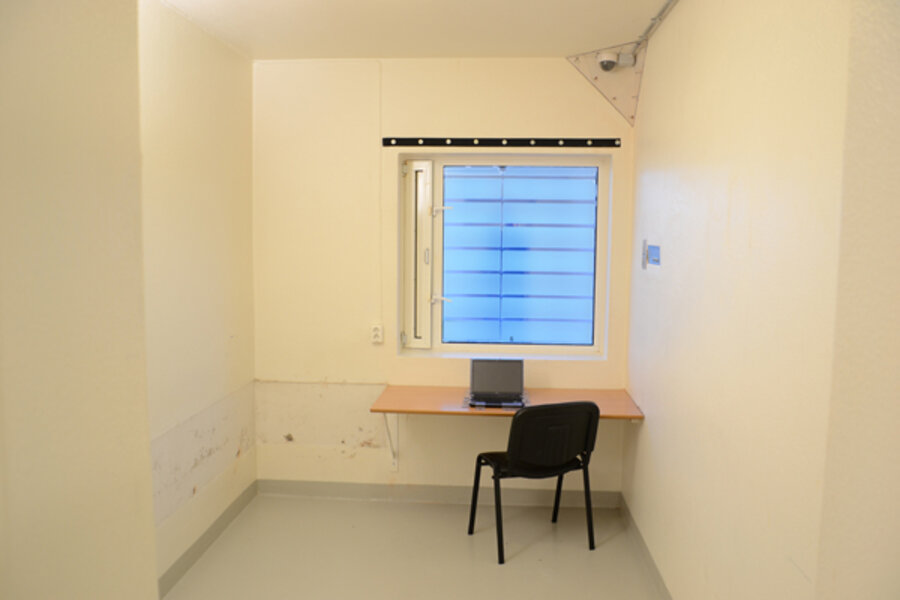How does Norway rehabilitate Anders Behring Breivik?
| Eiksmarka, Norway
Norway’s attitude toward criminal offenders is to rehabilitate them back into society, rather than punish them. The tolerant Nordic country has one of the lowest recidivism rates in the world, 20 percent compared with about 50 percent in the United States.
But what do you do with a mass murderer like the 33-year-old Norwegian responsible for single-handedly killing 77 last year in the country’s worst peacetime national tragedy?
That is the current dilemma facing Ila maximum security prison, the jail where Anders Behring Breivik has started serving his 21-year sentence for a car bomb attack on government headquarters in Oslo and a shooting spree at the Norwegian Labour Party summer youth camp on Utøya island.
The current feeling among victims, and conveyed in the judges’ ruling last month, is that Mr. Breivik should remain locked up forever. But Norway does not have life sentences per se. His sentence allows for his term to be rolled over indefinitely in five-year intervals if there is a risk of reoffending. Still, the prison is required to rehabilitate him.
“We cannot say to someone, you are never going to be released, so you can’t have access to this [rehabilitation] program,” says Ellen Bjerke, special adviser at Ila prison.
Breivik will be returning soon to Ila from his temporary stay at Skien prison following some prison modifications. He comes back to his three-room high-security wing inside the barbed-wired fortress at Ila, which lies in the leafy idyllic suburb of Baerum just a half hour outside Oslo, past the exclusive rolling greens of Grini Golf Club and a Christmas cake factory.
Old Nazi prison
Ila is one of the few high-security prisons in Norway. It was originally built in the 1930s as a women’s prison, but it is known more for its use as an internment camp by the Nazis during World War II and later to incarcerate Norwegian traitors. Today, half of its 124 inmates are in preventive detention, an indefinite sentence in Norway reserved for the most heinous criminals – from sex offenders to murderers – and repeat offenders.
Despite the dangerous prison population, the guards at Ila are unarmed except for nightsticks, while the inmates cook freely with sharp knives in the prison kitchen and smith with real hammers, all without incidents. In the history of the prison, there has only been one case of an inmate killing another with a smuggled kitchen knife.
“It just works,” says Jan Arne Hansen, another special adviser at Ila.
Breivik, of course, will not be allowed to participate in these activities, at least not at the outset. Ms. Bjerke says the prison plans to introduce Breivik into its society “slowly and carefully.” He will serve at least the first year isolated in his special wing, with one room for exercise and another for reading and writing. He is allowed to go alone into a 20-by-20-meter open-air yard, secured by concrete walls and barbed wire overhead, but may not meet prisoners from other wings.
'We have certain rules and human rights'
After a while, though, the prison will have to allow him to socialize with the other inmates and give him a “job” to do. That could entail going to school, for which he would earn, like every other inmate, a wage of 50 kroner ($ 8.75) per day. He will even be allowed to vote and possibly go home for a brief visit after serving about seven years of his sentence.
“It is very clear for us that we have certain rules and human rights, so this is the way we are going to do this,” says Bjerke.
Breivik will shortly start his rehabilitation process at Ila after an 8- to 12-week induction process. But his case is extremely challenging: not because of popular opinion against him returning back to society, but because of the nature of his crime. Breivik claims he is a militant nationalist fighting against the ethnic cleansing of his people by the Muslim colonization of Europe. He defended the mass killings, most of which were of teenagers, as a means to prevent the "civil war" that he says would ensue from the Norwegian Labour Party’s multicultural and lenient immigration policies.
“Is it his ideology we go after? His actions?” asks Mr. Hansen. “It’s interesting.”
Should Breivik have access to a computer?
One of the other conundrums is whether Breivik should be allowed the use of a personal computer to spread his political message.
The police had initially granted him the right during pretrial detention as part of its negotiations with Breivik, but took the privilege away after sentencing. He wants to use a computer to write a political trilogy of English-language books, much to the ire of victims’ families. Bjerke says the prison administration has not decided yet on whether to allow him a computer, but it is “not part of their job” to hinder free speech so long as there is no criminal content.
In total, the prison plans to spend 7.9 million kroner ($1.4 million) per year on Breivik, about 6.7 million kroner more than the average spent on normal-detention prisoners. He will be given an individual rehabilitation plan to follow. And if he does, he could technically be ready for return back into society, despite the extreme nature of his crimes. Whether Breivik – who would by then be in his 50s – qualifies is another question.
“We don’t know what makes people change,” says Hansen. “The age? Sometimes they get religious.”






